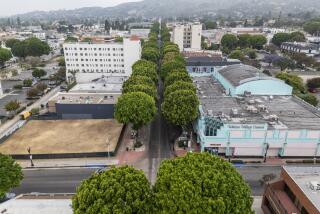A million L.A. trees: Will they take root?
- Share via
Monica Barra went to South Los Angeles last month to attend a jazz festival. She went home with a free tree, a one-gallon African sumac that she lugged around on a Sunday afternoon past the shops and restaurants of Leimert Park.
The college senior took the tree on an impulse, though each tree recipient was required to fill out a “pledge to plant,” a form smaller than an index card and a signature feature of Mayor Antonio Villaraigosa’s plan to plant 1 million trees across Los Angeles.
Six weeks later, Barra’s leafy friend has yet to make contact with the soil. Because Barra has no land of her own, the tree sits in her apartment in Redlands, roughly 60 miles from Los Angeles.
“I just really like having trees and plants where I’m living,” said Barra, who majors in literature, historiography and urban studies. “And it was free.”
Villaraigosa has trumpeted his Million Trees LA initiative as a cornerstone of his environmental agenda, bringing it up before audiences as far away as London and Hong Kong. Each time, the mayor’s refrain has been the same: “We’re planting 1 million trees,” a phrase that brings to mind a populace working harmoniously to transform Los Angeles into a verdant forest.
The reality, however, is that, in many cases, organizers are not so much planting trees as giving them away, offering them up by the hundreds at fairs, festivals and farmers markets, many of them in the summer in a year of intense drought.
So far, no one has checked to see whether those trees have been planted, are still alive or even are in Los Angeles, one of several cities pursuing massive tree initiatives.
More than two years into his term, Villaraigosa is roughly one-tenth of the way toward his tree-planting goal. Of the roughly 110,000 he lists as planted, more than half -- 51% -- were given away to the public. Of those given away, more than a third were seedlings: slender wisps that die unless they are planted immediately, tree advocates say.
The giveaway strategy has proved controversial among the city’s environmentalists, who praise the mayor for focusing on trees yet worry that the program has been too fixated on a numerical goal.
“It’s giving away trees to get your numbers up,” said Peter Lassen, a member of the city’s Community Forest Advisory Committee.
The issue is especially relevant now that Villaraigosa aides say they expect as many as 70% of the trees to be distributed to private property owners: 700,000 trees over the life of the program.
With each weekend giveaway, more people have filled out the pledge cards. And Barra’s experience is hardly unique.
Teacher Yvette Davis took an olive tree and an African sumac from a Million Trees booth the same day as Barra. Both went onto a patio.
Then there’s Koreatown resident Keita Mellion, a 26-year-old musician who also picked up a free tree at the jazz festival. Mellion has struggled to keep his seedling alive since August, when he went out of town for a week and a half and made no plans for watering it.
“I don’t think the environment is very conducive to it,” said Mellion, describing the tree that sits on his apartment patio, still encased in its one-inch plastic container. “It looks dried up.”
Although Million Tree coordinator Lisa Sarno said Villaraigosa’s team expects one out of every four trees to die, Lassen said the usual mortality rate for a tree given away at a fair is at least 50%.
The spur-of-the-moment tree adoptions are drawing sharp questions from Los Angeles City Councilwoman Janice Hahn, whose district has the fewest shade trees in the city, according to a city survey. Hahn said visitors to a festival are not necessarily dependable candidates for expanding the city’s urban forest.
“It’s sort of like adopting a bunny at Easter,” she said. “People say, ‘This will be fun.’ And then it falls by the wayside. They don’t have time, they go on vacation, and they’re not really committed to it. Only the problem with [the trees] is you can’t give them back. They just die.”
Villaraigosa’s tree team defended the 187 tree adoption events held so far, saying they are part of a civic engagement process that is essential to the program’s long-term success. They also said they will develop a follow-up system by the end of the year.
“People love things that are free,” said public works commissioner Cynthia Ruiz, the mayor’s spokeswoman on the program. “And when they learn about the benefits of the trees, it’s a win-win for everyone.”
Villaraigosa’s office says the city will be noticeably greener once the project is finished. And although the mayor’s team said in July that it expected to reach 1 million by 2012, Ruiz said that deadline is increasingly less important.
“I’m not so much focused on the time frame,” she said. “I’m just focused on having a successful million tree program.”
In some ways, the Million Trees initiative resembles a larger agenda promoted by Villaraigosa immediately before and after he took office.
Since his election in 2005, the mayor has retreated from his plan for seizing control of the Los Angeles Unified School District, settling for a few dozen “partnership” schools. Despite his promise to get more money out of Sacramento, Villaraigosa watched helplessly this year as state lawmakers raided local transit funding to balance their budget.
Still, few programs had as much difficulty gaining traction as the tree initiative, which has been repeatedly reworked. When the program was launched, Villaraigosa originally promised to add 300,000 new trees in the city’s parks. As of July, the Department of Recreation and Parks had planted 4,200, according to the mayor’s office.
Although Million Trees was billed as a $70-million program when it was rolled out last year, the mayor has raised just $3.2 million in private donations so far; $11.2 million has come from public agencies, four-fifths of it from the Department of Water and Power and the Port of Los Angeles.
Backers of the program point to its tangible successes: rows of sycamores, oaks and citrus trees added to neighborhoods that include Cypress Park, El Sereno and Boyle Heights.
Furthermore, nonprofit groups involved in the program say it should be judged not only on the numbers but also on its other benefits, from tree-care workshops to classes that will teach 8,000 students the value of having shade to cool the city.
“If you have a kid that walks home from school with a seedling and learns about what the tree can contribute to the environment, there’s a value there that transcends the tree’s actual survival,” said Larry Smith, who heads the nonprofit North East Trees.
Behind the scenes, environmental groups long resisted the 1 million goal, saying such a number is arbitrary and could lead to hastily offered plants and fewer long-term benefits.
Tree advocates recommended that Villaraigosa take 10 years, not four, to reach his target, Smith said.
Meanwhile, one group decided it would rather hold just one tree giveaway each year: a massive citywide adoption of fruit trees in January, the height of the rainy season.
Andy Lipkis, president and founder of Tree People, said his group is pursuing the slower, more painstaking work of showing residents how to plant and care for a tree over the long term, even if that results in fewer new trees.
“We didn’t want to buy into a numerical goal, not because numbers aren’t important but because we’ve seen that whenever they’re locked into a numerical goal, no matter what their higher goals were, at some point, they focus just on getting the numbers,” he said.
Tree People embarked on a campaign similar to Villaraigosa’s nearly three decades ago, asking Angelenos to plant 1 million trees in preparation for the 1984 Olympics.
But unlike the mayor, Tree People did not consider a giveaway tree as planted unless the owners went to the trouble of mailing back a postcard stating it had gone into the ground.
Villaraigosa’s Million Trees program was formally launched one year ago, after 12 months of planning with half a dozen tree organizations. The mayor said it would beautify the city while creating shade to cool its low-income neighborhoods.
The concept was based largely on a “canopy analysis,” a study that examined the places that had the fewest shade trees. Not surprisingly, the survey found that neighborhoods with large, mature trees -- the kind that form a soaring arc over a street -- were usually the ones with the greatest wealth. Consider the giant jacarandas that tower over sections of Sherman Oaks or the camphor trees that line the streets of Hancock Park.
With tree cover the thinnest south of the 10 Freeway, the Million Trees initiative has gone to such places as the jazz festival in Leimert Park, Ralphs supermarket on Crenshaw Boulevard and the farmers market in Watts.
On a hot day in July, the Koreatown Youth and Community Center -- one of the groups carrying out the Million Tree program -- provided 174 trees to patrons at the Watts market, held each Saturday in the parking lot of Ted Watkins Park.
Two-thirds of them were seedlings.
Yet seedlings are the most hotly contested component of Villaraigosa’s arboreal initiative.
Smith predicted that no more than one in four will survive.
The tree could dry up “just between the time you put it in your car and you take it home,” Smith said.
Sarno, Villaraigosa’s top advisor on the trees program, said the mayor plans to reduce the program’s reliance on seedlings. But that decision was made after more than 20,000 seedlings had been given out.
In May, tree groups distributed 2,300 seedlings at the two-day UCLA Jazz & Reggae Festival. And in June, organizers gave away 338 outside La Curacao, a department store in Pico-Union popular among Central-American immigrants.
The seedlings demonstrate how difficult it is to add trees in a city with a high concentration of renters and low-income residents.
Million Tree participants would much rather give away trees in one- and five-gallon pots, said Dore Burry, environmental manager for the Koreatown Youth and Community Center. The problem, he said, is that the people who approach his booth at festivals and fairs frequently want something they can pop into a shopping bag.
“In South-Central, you don’t have sprawling estates where they have open space,” he said. “But they’re willing to plant a seedling, because they have 10 to 15 years before they have to worry about it.”
Hahn said she picked up three seedlings at various events over the years, none of them affiliated with the mayor’s initiative. Two died and one never made it into the ground, she said.
Even the mayor’s employees have been slow to get seedlings into the soil. One fragile seedling, which has a Million Trees sticker on its plastic pot, sits on the carpet on the mezzanine of City Hall.
--
More to Read
Sign up for Essential California
The most important California stories and recommendations in your inbox every morning.
You may occasionally receive promotional content from the Los Angeles Times.











